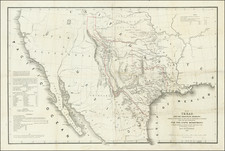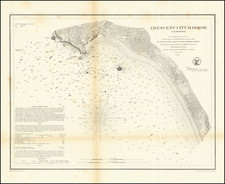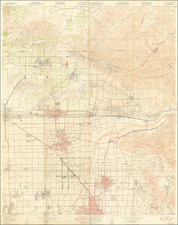An exceedingly rare map of San Francisco's Chinatown, printed almost entirely in Chinese for the Consolidated Chinese Benevolent Association, issued at the height of Inspector Jack Manion's war against the neighborhood's Tongs.
This fascinating map depicts the largest Chinatown in North America during the Roaring '20s, an especially dramatic period in the neighborhood's history. The map is horizontally centered on Grant Street (then Grant Avenue), the heart of neighborhood, and embraces the city blocks between Bush Street in the south, Broadway Street on the north, Powell Street on the west, and Montgomery Street on the east. While the names of streets and a few properties are given in English, all of the other typography is presented in Chinese. Each block is divided into building lots, fronted by the appropriate street address numbers. The detail of the map is quite unique, almost to the level of a fire insurance map--each of the buildings with second floors are noted with a symbol for stairs.
Critically, only Chinese-owned businesses are identified in Chinese script, and while a few non-Chinese owned properties are labeled in English, for the most part they are left entirely blank (indicating that they were of little interest). Two detailed insets in the left-hand corners of the map feature a map of downtown San Francisco showing the position of Chinatown, while the other features a map of the central Bay Area, showing the relative positions of San Francisco's Chinatown and Oakland's Chinatown. An interesting use of symbols is on the directional compass (in the upper inset), which has the rising sun as a second symbol for the eastern direction.
Importantly, the map was printed by Chinese San Franciscans for use by the Chinese community. This is in sharp contrast to earlier maps of the neighborhood, which were made for a non-Chinese audience, such as Willard B. Farwell's Official Map of Chinatown in San Francisco (1885), which was made for the Board of Supervisors to analyze the nature of crime in Chinatown.
While not explicitly noted, the map was issued at the direction of the Consolidated Chinese Benevolent Association, also known as the 'Chinese Six Companies'. This community association was formed in 1882, following the union of several different entities to provide a central administration for controlling and assisting the neighborhood's Chinese residents, and representing the community to the city at-large. It was formed during a climate of especially severe racism, following anti-Chinese riots in the 1870s and the passage of the Chinese Exclusion Act of 1882 by the U.S. Congress, which technically forbade all new immigration from the Middle Kingdom. The Benevolent Association played a vital role in charitable works and governance in what was a semi-autonomous enclave within the greater city.
The official purpose of the present map was for the Benevolent Association to monitor Chinese businesses in the neighborhood and to keep track of who had paid (and who had not paid) their financial dues to the Association. It has been related that at the time, tacks were placed into the map on properties that were in arrears.
Perhaps even more interestingly, it is thought that that the map was employed for another more sinister purpose. Tongs, or Chinese criminal secret societies had long been a scourge of the neighborhood. The Tongs operated an uneasy parallel authority to the Benevolent Association and all of the neighborhood's residents lived in fear of the extremely violent methods the societies' members were known to employ. While the 1906 San Francisco Earthquake, which entirely destroyed the neighborhood, dealt a severe blow the Tongs, over the years that followed they managed to rebuild their powerbase. In addition to paying their dues to the Benevolent Association, Chinese business owners often had the pay 'protection money' to one of the Tongs. In times when business was slow, these proprietors often found it difficult to satisfy both of these debts. Lore has it that examples of this map were used by the Tongs to keep track of who was in arrears. Those unfortunates could soon expect a visit from a Tong member 'encouraging' their compliance.
This all being said, the 1920s and 1930s were viewed as the Tongs' 'Last Hurrah', for since 1921 the 'Chinatown Squad' of the San Francisco Police Department had been led by the incomparable Inspector John J. (Jack) Manion, the Bay City's answer to Elliot Ness. Along the warren of streets and alleys, and inside many of the properties shown on the map, Manion's 16-member squad launched innumerable raids and had a series of dramatic alternations with the Tongs. Manion's skilled determination, combined with more severe legislation against gambling, drug dealing and prostitution finally broke the back of the secret societies.
The map is an authentic and important primary source on life in Chinatown during the Roaring '20s, and merits detailed study by local historians. The map is extremely rare, and we are aware of no other examples ever appearing in dealers' catalogs or in auction records and we can locate only a single institutional example, at the Dwight B. Waldo Library at Western Michigan University (Kalamazoo).









![[Charles Lindbergh - 1st Trans-Atlantic Flight - Printed on Linen]](https://storage.googleapis.com/raremaps/img/small/69233.jpg)
![(Humboldt Atlas and Text) Geographique et Physique du Royaume de Nouvelle-Espagne [with quarto text:] Essai Politique de la Royaume de la Nouvelle-Espagne](https://storage.googleapis.com/raremaps/img/small/99796.jpg)

![[ Death Valley - Furnace Creek Ranch ]](https://storage.googleapis.com/raremaps/img/small/98985.jpg)

